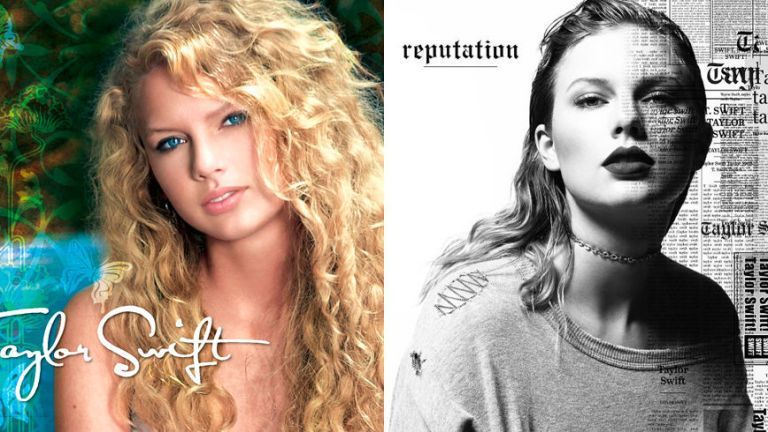The Fascinating Evolution of Taylor Swift's Sound, from 2006 to Now
There are definitely no more teardrops on her guitar.

Taylor Swift's new single, "Look What You Made Me Do," is a dark departure for the singer—pretty much everyone seems to agree on that. Old Taylor might be dead, but she's died before (as Swift self-awarely alludes to in the song's lyrics); on each album, we've met a New Taylor. The new New Taylor just happens to be the starkest change we've seen so far.
Here's a look at how Taylor's sound has changed over the years and yet how, as an artist, she's definitively stayed the same.
'Taylor Swift,' 2006
It's fitting that Taylor's debut album was self-titled because, more than anything else she released after, it conveyed a sense of authenticity. Taylor is a songwriter and a storyteller first and foremost, so it's not surprising that she gravitated to country music. And, considering she was 17 when the album was released, it's also not surprising that listening to it feels like reading someone's diary.
"Teardrops on My Guitar" established Taylor's willingness to not just draw from her life in songs, but to put in real details (like not changing names to protect the not-so-innocent).
'Fearless,' 2008
In 2008, Taylor made her first big steps toward the pop world. Fearless was still considered a country album, but the big singles, "Love Story" and "You Belong With Me," were infused with pop. Here, we get a more cheerful Taylor. Whereas 2006 Taylor was a girl who felt like an outsider and who let sadness seep into her sound, 2008 Taylor was reborn as a, well, more fearless version of herself.
In 2006, a crush not liking her back meant teardrops on her guitar; in 2008, it was a chance to confidently declare that he was making the wrong decision if he wasn't with her.
'Speak Now,' 2010
For 2010's Speak Now, Taylor made the conscious decision to write the entire album herself. The result is her most uniform album, sonically. Speak Now is folkier than Taylor's other albums and the songs are, musically, much more straightforward, which puts the lyrics (the heart and soul of all Swift songs) front and center.
Stay In The Know
Get exclusive access to fashion and beauty trends, hot-off-the-press celebrity news, and more.
A highlight of the album was "Back to December," which is unique in Taylor's catalogue in that it's a breakup ballad, but also an apology song. Writing a whole album solo seemed to lead Swift toward some very deep introspection.
'Red,' 2012
Taylor might not have *officially* gone pop until 2014, but 2012's Red towed that line as much as it possibly could without totally stepping over it. Singles like "We Are Never Ever Getting Back Together" and "I Knew You Were Trouble" felt like beta tests for the Taylor that was to come, while tracks like "All Too Well" were firmly old school Swift.
What's notable about Red, aside from the sonic dissonance, is that it really served as an almost perfectly chronological record of the two years between Speak Now and its release. At this point, Taylor's private life was largely on the public record, and rather than fight against that, she used it as a framing device for the album.
'1989,' 2014
Taylor's biggest musical leap, so far, came with her last album, 1989, on which she went full pop and crafted a modern sound that paid homage to her birth year. Sonically, it marked the biggest statement of Swift's career and the first time she made her desire for professional invention explicit.
It was also the first time that Taylor expressed awareness of her public image in her music. "Shake It Off" and "Blank Space" both explicitly addressed the media portrayal of her dating life and played on it.
'Reputation,' 2017
If "Look What You Made Me Do" proves to be representative of the rest of Reputation, Taylor is telling the world that she's ready to go dark and more than just on social media.
What's never changed:
Even as she experiments with new sounds and new versions of herself, however, one thing that's remained constant is her confessional songwriting ("duh," says every one of her fans everywhere). Taylor is a woman who really feels things and she puts those feelings directly into her music. So, no matter how dark and twisty her new album gets and no matter what sound it takes, we should count on it to represent exactly how Taylor felt as she processed everything that's happened to her in the last three years—which, as we all know, is a lot.
Follow Marie Claire on Facebook for the latest celeb news, beauty tips, fascinating reads, livestream video, and more.
Kayleigh Roberts is a freelance writer and editor with over 10 years of professional experience covering entertainment of all genres, from new movie and TV releases to nostalgia, and celebrity news. Her byline has appeared in Marie Claire, Cosmopolitan, ELLE, Harper’s Bazaar, The Atlantic, Allure, Entertainment Weekly, MTV, Bustle, Refinery29, Girls’ Life Magazine, Just Jared, and Tiger Beat, among other publications. She's a graduate of the Medill School of Journalism at Northwestern University.
-
 Meet the Cast of 'The White Lotus' Season 3, From the New Guests Checking In to the Surprising, Returning Characters
Meet the Cast of 'The White Lotus' Season 3, From the New Guests Checking In to the Surprising, Returning CharactersHBO rounded up a handful of A-listers for the anthology's Thailand-set installment.
By Quinci LeGardye Published
-
 Jennifer Lopez Dips Her Fingers Into a Rising Manicure Trend
Jennifer Lopez Dips Her Fingers Into a Rising Manicure TrendIt's the perfect shade for solo V-Day plans.
By Hanna Lustig Published
-
 Prince Charles Sent Princess Diana an Unexpectedly Touching Letter Before Their Wedding
Prince Charles Sent Princess Diana an Unexpectedly Touching Letter Before Their WeddingThe late royal shared the details of his intimate card and personalized gift.
By Kristin Contino Published
-
 Beyoncé Wins Album of the Year for the First Time Ever at the 2025 Grammys
Beyoncé Wins Album of the Year for the First Time Ever at the 2025 GrammysThe superstar—who has the most wins in the award show's history—took home the biggest prize of the night for 'Cowboy Carter.'
By Sadie Bell Published
-
 Chappell Roan Wins Best New Artist at the 2025 Grammys—And Called Upon Record Labels to Enact Artist Healthcare Reform
Chappell Roan Wins Best New Artist at the 2025 Grammys—And Called Upon Record Labels to Enact Artist Healthcare ReformThe Midwest Princess made a powerful speech while accepting the award for Best New Artist.
By Quinci LeGardye Published
-
 Beyoncé Wins Best Country Album at the 2025 Grammys
Beyoncé Wins Best Country Album at the 2025 GrammysThe superstar is the first Black woman to ever win the honor.
By Quinci LeGardye Published
-
 Doechii Wins Best Rap Album at the Grammys and Dedicates the Award to Black Women: "You're Exactly Who You Need to Be"
Doechii Wins Best Rap Album at the Grammys and Dedicates the Award to Black Women: "You're Exactly Who You Need to Be""The Swamp Princess" is the third female rapper to take home the gramophone.
By Quinci LeGardye Published
-
 Everything to Know About the 2025 Grammys, From How to Watch the Awards Show to the Performers
Everything to Know About the 2025 Grammys, From How to Watch the Awards Show to the PerformersAll of your favorite pop divas are set to take the stage.
By Quinci LeGardye Published
-
 RAYE Shares What Music Shaped Her—And What's on Her Playlist Now
RAYE Shares What Music Shaped Her—And What's on Her Playlist NowThe Best New Artist-nominated singer discusses Britney Spears, Charli xcx, and Nina Simone.
By Quinci LeGardye Published
-
 How Failure Felt Like "Business School" for Ashley Tisdale—And Helped Propel Her Brand Forward
How Failure Felt Like "Business School" for Ashley Tisdale—And Helped Propel Her Brand ForwardThe actress, singer, and Frenshe founder speaks to editor-in-chief Nikki Ogunnaike for the 'Marie Claire' podcast "Nice Talk."
By Sadie Bell Published
-
 Let Ethel Cain's Defiance Guide You Through 2025
Let Ethel Cain's Defiance Guide You Through 2025In the wake of Donald Trump's re-election, the indie singer's outspokenness has become a balm for fans.
By Sadie Bell Published